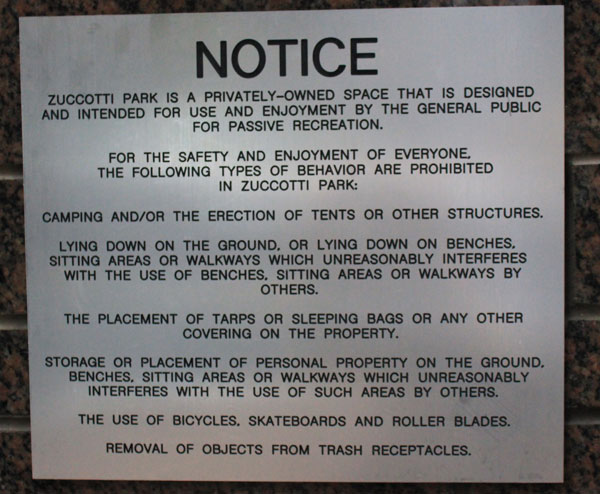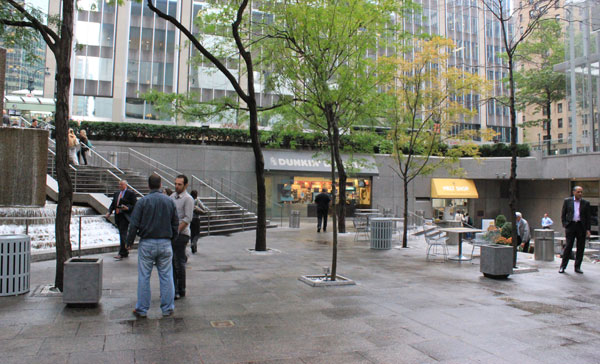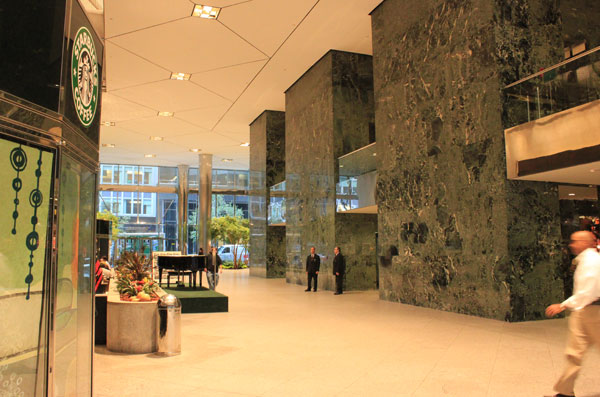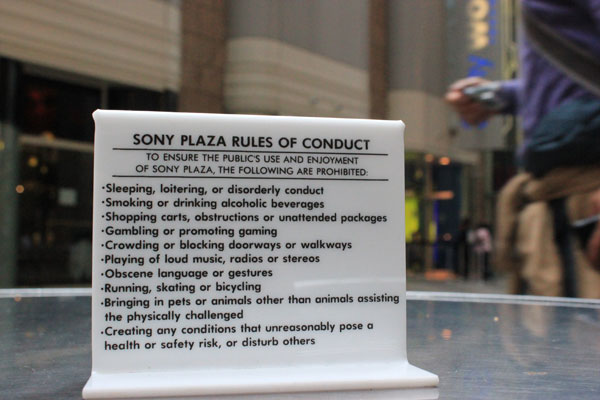When the Occupy Wall Street demonstration began on September 17, protesters were quickly blocked from Wall Street and settled into nearby Zuccotti Park for their occupation. But as this morning’s near-eviction by New York Police at the behest of owners Brookfield Properties made clear, Zuccotti isn’t a public park with all the free speech protections that come with public property; rather, it’s a privately owned public space.
Privately owned public spaces have proliferated in the past several decades—there are almost 550 in New York City—as a result of zoning concessions the city grants to real estate developers: in exchange for setting aside a nominally public space, property owners such as Brookfield are allowed to bypass height or setback restrictions on their buildings.
 But the problem with privately owned public spaces is that they’re no substitution for purely public spaces, because First Amendment protections don’t really apply when the owners of a space are non-governmental. Jerold Kayden, a professor of urban planning and design at Harvard’s Kennedy School, says that these spaces “occupy a somewhat murky terrain in terms of what activities and conduct of public users within the space should be acceptable and what goes beyond the pale." That is, the protesters have been able to set up camp in Zuccotti not because of any regulation that protects their presence there, but precisely because of a real lack of any defined regulations at all. As Ben Adler noted today, that’s been a boon to the occupiers: "It is only because Zuccotti Park falls into a nebulous area that the NYPD maintained until Thursday that they did not have the authority to eject the protesters." Brookfield has scrambled to make new rules that seem to be purpose-built to end the occupation (click the image above enlarge), but the occupiers aren’t falling for it.
But the problem with privately owned public spaces is that they’re no substitution for purely public spaces, because First Amendment protections don’t really apply when the owners of a space are non-governmental. Jerold Kayden, a professor of urban planning and design at Harvard’s Kennedy School, says that these spaces “occupy a somewhat murky terrain in terms of what activities and conduct of public users within the space should be acceptable and what goes beyond the pale." That is, the protesters have been able to set up camp in Zuccotti not because of any regulation that protects their presence there, but precisely because of a real lack of any defined regulations at all. As Ben Adler noted today, that’s been a boon to the occupiers: "It is only because Zuccotti Park falls into a nebulous area that the NYPD maintained until Thursday that they did not have the authority to eject the protesters." Brookfield has scrambled to make new rules that seem to be purpose-built to end the occupation (click the image above enlarge), but the occupiers aren’t falling for it.
All of which highlights the ambiguous nature of our cities’ many public-yet-not-public spaces. “The owners of these spaces or the developers of the buildings in which the spaces exist received zoning concessions to encourage the provision of these spaces and the owners continue to enjoy the financial benefits of these zoning concessions," Kayden explains. “It’s only right that the public should enjoy their part of the bargain.” If Brookfield seems determined to flex its power over Zuccotti in the near future, what are some other privately owned public spaces the Occupy Wall Street movement might they test out next?
Popular
"swipe left below to view more authors"Swipe →
60 Wall Street: Headquarters of Deutsche Bank

A few blocks away from Zuccotti Park, the ground floor of 60 Wall Street is a large and well-lit lunch break oasis complete with tables and artificial palm trees that is open to the public from 7am to 10pm. Significantly, it’s indoors, a fact that likely won’t go unnoticed by the Occupy Wall Street movement as the winter months come to New York.
180 Maiden Lane: Continental Center

Also a short walk from Zuccotti, the Continental Center’s futuristic jungle-gym atrium could serve as another base for the occupiers: the indoor area, with a food kiosk and restrooms, is open during weekdays from 8:30am until 5:30pm. Outside of those times, the building’s outdoor space remains accessible to the public 24 hours a day.
153 East 53rd Street: Citigroup Center

Further uptown, the Citigroup Center has two levels of public space with plenty of amenities: restaurants, tables, restrooms and subway access. The lower level plaza, which features a waterfall and Dunkin’ Donuts, is open to the public at all times. Not to mention that the protesters could find worse targets for their occupation than Citigroup.
55 East 52nd Street: Park Avenue Plaza

The ground floor Park Avenue Plaza arcade, open 8am to 10pm, is one of the more inviting privately owned public spaces and is clearly labeled for public use. With such creature comforts as bicycle parking, restrooms and drinking fountains, occupiers could really settle in.
The building houses offices for retail broker Morgan Stanley Smith Barney, derivatives broker MF Global and insurance giant Swiss Re, and the arcade’s many trees therefore boast some very high-tech foliage.
550 Madison Avenue: Sony Building

The Sony building’s pedestrian space, which houses the Sony Wonder Technology Lab, is open longer than most privately owned public spaces: from 7am until 11pm. With restaurants and restrooms, the building may seem like a prime target for occupiers. But the management has taken efforts to post clear signs on each table outlining regulations for the space.
590 Madison Avenue and 725 Fifth Avenue: IBM Building and Trump Tower

 Directly across 56th Street from the Sony building, however, are two connected privately owned public spaces.
Directly across 56th Street from the Sony building, however, are two connected privately owned public spaces.
The IBM building’s sculpture park could provide a large-yet-enclosed area ideal for a winter occupation, and the adjacent Trump Tower mall houses restaurants, restrooms, luxury stores and even a gift shop in which occupiers can buy merchandise to send a clear message to people like Donald Trump.
These locations may not be altogether practical for the occupiers, and in fact protesters would likely face strong resistance from the properties’ owners if they were to try to hold any of these plazas and atriums. But the fact that most of these privately owned public spaces are in the lobbies of banks and corporations is a powerful metonym for the way money is shaping our cities and our society. If Zuccotti falls, where will the occupation move next?



